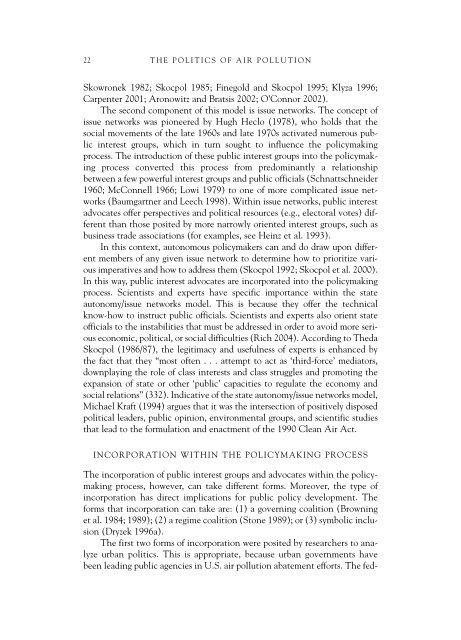GEORGE A. GONZALEZ - fieldi
GEORGE A. GONZALEZ - fieldi
GEORGE A. GONZALEZ - fieldi
You also want an ePaper? Increase the reach of your titles
YUMPU automatically turns print PDFs into web optimized ePapers that Google loves.
22THE POLITICS OF AIR POLLUTIONSkowronek 1982; Skocpol 1985; Finegold and Skocpol 1995; Klyza 1996;Carpenter 2001; Aronowitz and Bratsis 2002; O’Connor 2002).The second component of this model is issue networks. The concept ofissue networks was pioneered by Hugh Heclo (1978), who holds that thesocial movements of the late 1960s and late 1970s activated numerous publicinterest groups, which in turn sought to influence the policymakingprocess. The introduction of these public interest groups into the policymakingprocess converted this process from predominantly a relationshipbetween a few powerful interest groups and public officials (Schnattschneider1960; McConnell 1966; Lowi 1979) to one of more complicated issue networks(Baumgartner and Leech 1998). Within issue networks, public interestadvocates offer perspectives and political resources (e.g., electoral votes) differentthan those posited by more narrowly oriented interest groups, such asbusiness trade associations (for examples, see Heinz et al. 1993).In this context, autonomous policymakers can and do draw upon differentmembers of any given issue network to determine how to prioritize variousimperatives and how to address them (Skocpol 1992; Skocpol et al. 2000).In this way, public interest advocates are incorporated into the policymakingprocess. Scientists and experts have specific importance within the stateautonomy/issue networks model. This is because they offer the technicalknow-how to instruct public officials. Scientists and experts also orient stateofficials to the instabilities that must be addressed in order to avoid more seriouseconomic, political, or social difficulties (Rich 2004). According to ThedaSkocpol (1986/87), the legitimacy and usefulness of experts is enhanced bythe fact that they “most often ... attempt to act as ‘third-force’ mediators,downplaying the role of class interests and class struggles and promoting theexpansion of state or other ‘public’ capacities to regulate the economy andsocial relations” (332). Indicative of the state autonomy/issue networks model,Michael Kraft (1994) argues that it was the intersection of positively disposedpolitical leaders, public opinion, environmental groups, and scientific studiesthat lead to the formulation and enactment of the 1990 Clean Air Act.INCORPORATION WITHIN THE POLICYMAKING PROCESSThe incorporation of public interest groups and advocates within the policymakingprocess, however, can take different forms. Moreover, the type ofincorporation has direct implications for public policy development. Theforms that incorporation can take are: (1) a governing coalition (Browninget al. 1984; 1989); (2) a regime coalition (Stone 1989); or (3) symbolic inclusion(Dryzek 1996a).The first two forms of incorporation were posited by researchers to analyzeurban politics. This is appropriate, because urban governments havebeen leading public agencies in U.S. air pollution abatement efforts. The fed-









